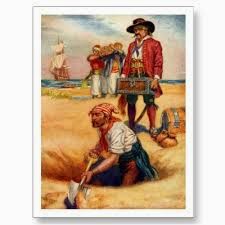1. Pirates were very bad guys.
Many movies and books portray pirates as
really, really bad guys. Not only do they take things that don’t belong to them
(kind of a requisite for the job) but they murdered whole crews of merchant
ships, burned towns, raped and tortured.
In fact: While few pirates were ever Sunday-school
teachers, most of them were no worse than any other blue-collar workers of the
time. They were rough, but they rarely hurt people, and the number of murders
committed by Golden-Age pirates was much smaller than might be imagined.
2. Pirate captains ruled with an iron hand
We see images all the time of pirate
captains stomping around giving orders, threatening beatings (the floggings
will continue until moral improves) even shooting members of their own crews.
In fact: On a pirate ship, the power lay
with the crew, not the captain. Captains needed the crew’s approval before attacking
a ship, changing course, making an alliance or breaking one. Pirate captains
were voted in and voted out regularly.
3. Pirates spent months and years at sea.
Movies give us strange ideas about life
at sea. Sometimes it seems like pirates in films never come to shore – or if
they do, it’s just to burn a few buildings, capture a fort, drink and whore for
an evening, and then head out on their trusty pirate ship.
In fact: The point of piracy wasn’t to
spend all their time crowded onto a boat. Ship time was work time, and time on
shore was for having fun. Obviously, the idea was to maximize the fun.
On average, the ordinary pirate spent more time whooping it up in town than at
sea, and tried to maximize that difference.
4. Pirates treated women terribly.
We’ve all seen this kind of stuff… Rape,
pillage, kidnap, and then during downtime beat up the bar maid. Or maybe pay
for a quick frolic between the sheets, but then head back out to sea as quickly
as possible. Best not to be a woman when pirates are around.
In fact: Like most men who spend large
amounts of time away from the fairer sex, pirates wanted more than just a quick
screw when female company was available. They wanted to take a woman out to
eat, take her dancing, and maybe even move in together. Some prostitutes, in
fact, only catered to pirates and sailors because they received significantly
better treatment from these men than from other customers.
5. Pirates had hook hands, peg legs and eye patches.
The surest way to identify a pirate in a
picture is to draw in one or more of these disabilities.
In fact: These tags were popularized by
writers eager to create distinctive pirate characters. In fact, pirates were no
more likely than other sailors to suffer this kind of injury. And pirates who
did lose body parts were compensated by their crews, and were able to buy a business
and retire from the sea.
6. Pirates had a distinctive way of speaking.
We’ve heard this:” Arr! Avast there,
matey! I be a pirate, and my mates be pirates as well!” You can always tell a pirate by the way he
speaks.
In fact: The accent that we think of as
being “pirate” is the creation of one man – Robert Newton, who played Long John
Silver for Walt Disney. It’s a real accent, from a part of England that
produced more than its share of pirates and smugglers. But pirates could come
from anywhere and their accents might be Irish, French, English, African, and
even nationalities like Greek, Spanish, Italian or Native American.
7. Pirate ships were huge and intimidating.
From Captain Hook’s Jolly Roger to the
Black Pearl, pirate ships have a certain look: Tall, with a raised platform in
the back, big square sails on three masts, and a huge number of guns.
In fact: Pirate ships were small and
nimble, usually with only one or two masts, and most often had triangular sails.
Most pirates carried fewer than 10 guns. And some of the most famous pirates
started with not much more than a canoe.
8. Pirates were white guys.
Oh, maybe there were one or two people
of color in a pirate crew. But, after all, most pirates were English, and any
differences were just anomalies that added variety to a mostly Caucasian crew.
In fact: Pirates often freed African
slaves and allowed these people to join their crews, so the percentages of
Africans in pirate crews was often very high. For a while, Black Sam Bellamy
had more Africans than Europeans in his crew. And there are rumors that
Blackbeard himself had African ancestry.
9. Pirates buried treasure.
When a pirate captain amassed a huge
amount of gold, he headed to some secluded island, buried it, killed the crew
members who had helped him, and made a map, which he jealously guarded.
In fact: It’s all hogwash. Pirates didn’t
live very long (most people didn’t in the 18th century) and hiding
gold made no sense at all. The point was to spend it. Even if for some reason,
pirates wanted to bury treasure, any captain who tried that kind of shenanigans
would immediately lose his job.
10. Pirates wore striped socks.
In fact: You got me on that one. Striped
socks were an expensive item of clothing for a working-class guy, and it was
just the kind of hey-look-at-me-I’m-rich kind of accessory that a real pirate
might wear when he dressed up to go into town.










That was an interesting read, and has me taught me much about how to be a more believable pirate. Thank you for writing this as it will help to further our cause: http://piratesforlife.blogspot.co.nz/
ReplyDeleteI need to know who the man is in the first picture. My uncle passed away a year ago on 10/18/19. This man looks identical to him. My heart instantly hurt seeing his beautiful face.
ReplyDelete